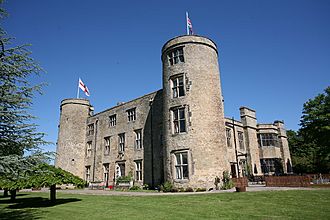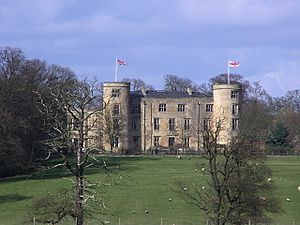Walworth Castle facts for kids
Quick facts for kids Walworth Castle. Website - www.walworthcastle.co.uk |
|
|---|---|

South−east corner of Walworth Castle
|
|
| General information | |
| Type | Manor house |
| Architectural style | Tudor style architecture |
| Location | Walworth County Durham, England |
| Coordinates | 54°33′54″N 1°38′20″W / 54.565°N 1.639°W |
| Elevation | 300 feet (91 m) |
| Construction started | c. 1579 |
| Completed | c. 1600 |
| Renovated | 1740; 1864; 1991; 2000; 2016 |
| Client | Thomas Jennison |
| Technical details | |
| Structural system | Limestone rubble and Welsh slate |
| Design and construction | |
| Architect | Thomas Holt |
Walworth Castle is an old castle located near Darlington in County Durham, England. It was finished around the year 1600. People think Thomas Holt designed it for Thomas Jenison. The castle stands where an even older house or castle was built in the 1100s by the Hansard family.
Over the years, many different families owned Walworth Castle. During World War II, it was used as a prisoner-of-war camp. After the war, it became a boarding school for girls. Since 1981, Walworth Castle has been a hotel. It is a very important historic building, known as a Grade I listed building.
Contents
The Castle's Long History
Early Owners: Hansard and Ayscough Families
The first building on this spot was a manor house or castle. The Hansard family built it around 1150. There is no proof that this first building was ever used for fighting or defense.
After a terrible sickness called the Black Death in 1349, the castle briefly changed hands. But Robert Hansard got it back in 1391. The castle then stayed with the Hansard family for many years. It passed from father to son through several generations.
In 1539, Elizabeth Hansard married Sir Francis Ayscough. This meant the castle then belonged to the Ayscough family. In 1563, Elizabeth's son, William Ayscough, took over. Since he had no children to pass it on to, the castle was sold.
The Jenison Family and Royal Visits
Around 1579, a man named Thomas Jennison bought the land. He was an important official in Ireland. He tore down most of the old medieval castle. He kept only the old south-west tower. Then, he built the castle we see today. It is believed that Thomas Holt was his architect.
Thomas Jennison died in 1586. His wife, Elizabeth, inherited the castle. A very important guest stayed here during her time. On May 14, 1603, King James VI of Scotland visited Walworth Castle. He was on his way to become King of England. It is said that the King was so well entertained that he knighted Elizabeth's son-in-law, George Freville.
In 1605, Elizabeth Jennison passed away. Her son, William Jenison, became the owner. The castle started to fall apart because William did not live there. He also had money problems and was put in prison. The Jenison family was strongly Catholic.
Later, in 1679, Francis Jennison sold the estate. He moved to Europe. This might have been because another family member, Thomas Jenison, was accused of being part of a plot against King Charles II. The castle was sold again in 1687. Ralph Jenison bought the whole estate for £6,205.
In 1689, the castle was searched for weapons. This was because people worried about a possible rebellion against the new rulers, William III and Mary II. Ralph Jenison inherited the castle in 1704 when he was only 10 years old. He spent a lot of money fixing up the castle. Because of this, he ended up in debt, and the castle had to be sold again.
New Owners: Stephenson, Harrison, Aylmer, and Eade Families
In 1759, a wine merchant named Matthew Stephenson bought the castle for £16,000. Then, in 1775, it was sold to John Harrison, a merchant from Newcastle. His daughter, Ann, married Arthur Aylmer, a British Army officer. So, the castle then belonged to the Aylmer family.
After General Aylmer died in 1831, his son, John Harrison Aylmer, inherited the castle. He fixed the roof. He also replaced old soldier statues on the towers with pillars topped with balls.
In 1868, a sad event happened. John Harrison Aylmer, his wife, and their oldest son died in a train accident. His younger sons, Vivian and Edmund, inherited the castle. Vivian was only 12 and Edmund was 9. Vivian later became a High Sheriff of Durham. He was also a big game hunter who explored faraway lands. He died in 1931.
The castle was then sold to Neville and Charles Eade, who were descendants of General Aylmer. During their time, in World War II, the castle was used as a prisoner-of-war camp. About 200 German and Italian officers were held there. In 1950, Durham County Council bought the castle. It then became a boarding school for girls.
Walworth Castle as a Hotel
In 1981, the Council sold the castle. It was renovated and then opened as a hotel. Today, it is part of the Best Western hotels group in the UK.
The Castle Building
This Tudor style castle was built around 1600. It is a manor house made of limestone rubble. Some parts are covered in plaster. The roof is made of Welsh slate.
The west tower is older than the rest of the castle. It has narrow windows and openings for guns. The main part of the castle faces south. It has five sections and three floors. There are two round towers on each corner, with four floors. East and west wings extend from the north side. This creates a square shape with a courtyard in the middle.
Until recently, the castle had stained glass from the 1600s. This glass has now been moved to the Bowes Museum. In 2002, old flagstones were found in the castle's basement.
The inside of the castle was updated in 1740. It now has beautiful plasterwork and fancy details from that time. In 1864, the main staircase was rebuilt. The west wing also got a new front. Walworth Castle is a Grade I listed building. This means it is a very important historic site.
Walworth Park and Grounds
Walworth Park
The land south of Walworth Castle was once farmland. You can still see signs of old ridge and furrow fields there. These fields might have belonged to a lost village nearby. There might have been another old settlement in the park too.
Castle Grounds and Features
North of the castle, there are 19th-century garden walls. These walls are made of brick and stone. There are also stone gate pillars with pyramid tops. A greenhouse is also located here. These features are also listed, meaning they are historically important. The greenhouse is made of wood and glass. It has a taller middle section and two lower sides.
An interesting discovery was made in 1937–1938. A medal, possibly belonging to Thomas Jennison, was found. He was the person who built the castle in the 1500s. It was found under the north wall of the castle grounds. The medal had a picture of a bridge and Thomas Jennison's name on it.
The castle lodge and gate were built in 1870. They are also listed. They were designed to look like the old castle. They have battlements, which are the notched tops of castle walls. The lodge is a single-story, L-shaped building. It has corner towers and rough stone walls.
Huts to the east of the castle might be where the World War II prisoner-of-war camp was located. The gardens north of the castle, including the greenhouse, were sold separately in 2010. They were used for growing plants to sell.
Walworth Castle Today
Walworth Castle has been open to the public on special National Heritage weekends. The castle is known for its ghost stories. The hotel has even used these stories for Halloween events.
The castle restaurant has received good reviews. In 2002, it earned a three-star rating from the RAC and AA. There have been some challenges with public transport to the castle.
In 2001, Walworth Castle Hotel became the 100th member of the Darlington and District Business Club. To celebrate the Golden Jubilee of Elizabeth II in 2002, the castle hosted a children's fancy dress party for charity.
Other charity events have been held at the castle. These include a car boot sale in 2002. In 2003, there was an event for Butterwick Children's Hospice. This event even featured people dressed as Viking raiders.
In 2007, the castle was lit up with pink lights for Valentine's Day. In 2008, the castle was part of a charity triathlon route. This event was organized by the local Rotary Club. In 2009, a local school held its formal ball at the castle. The building is also used as a polling station during elections.


